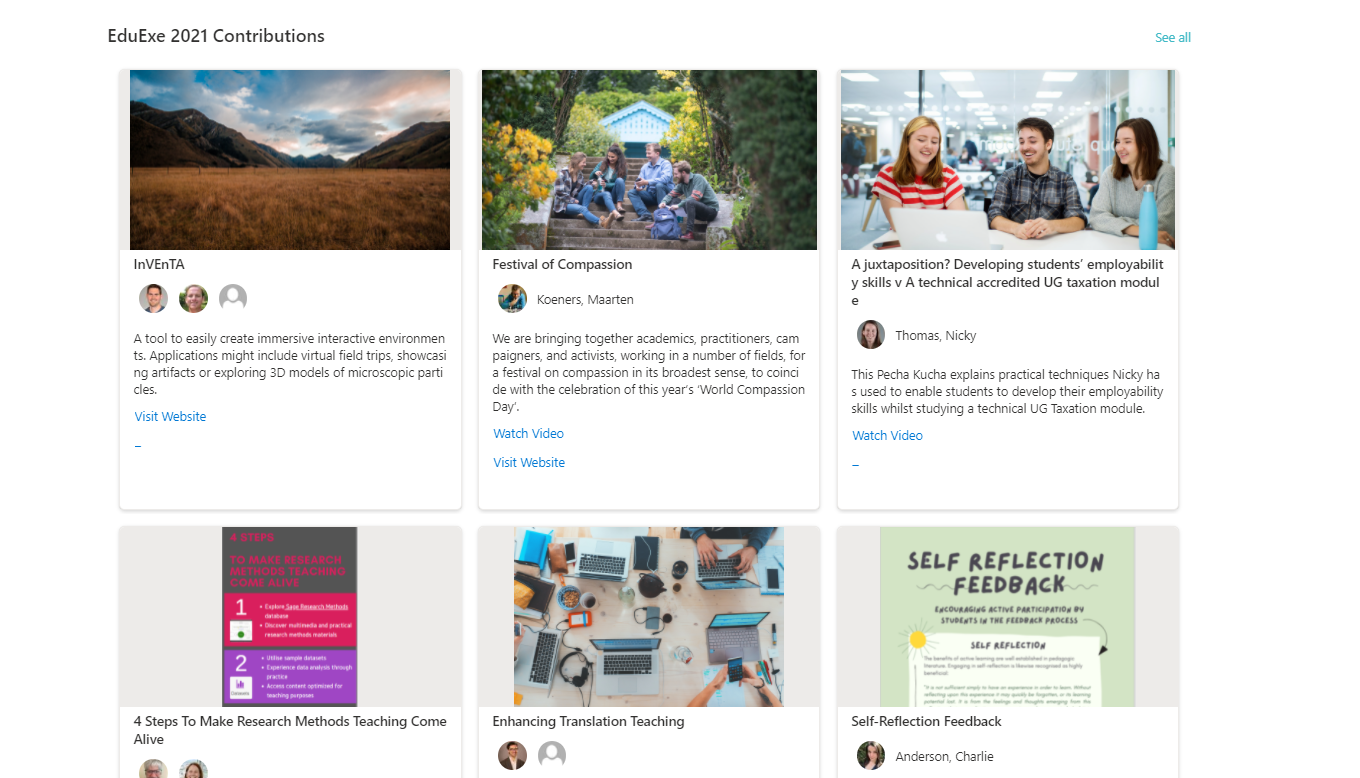The Move to HyFlex: Our Annual Teaching and Learning Conference
Giorgia Pigato and Cat Bailey explain how they used SharePoint to remove distance as a barrier and increased participation in the annual teaching and learning conference at the University of Exeter
Authors :Giorgia Pigato and Cat Bailey
1.What exactly was the shift in culture and/or organisational practice that you wish to highlight?
Our teaching and learning conference, EduExe, was traditionally held as an on-campus, in-person event. The conference forms part of our year-long professional development events for educators across the University. Participants are normally transported to one of the Exeter campuses and contributions are given as in-person presentations and workshops.
One of the challenges with face-to-face provision was engaging all Exeter University campuses which are located in Exeter and Cornwall. Colleagues not at the Exeter campus often complained they could not attend and felt excluded. In the past, we had tried to have hybrid sessions, but the rooms were either not available or we didn’t have IT support. As it wasn’t in the culture anyway, it was deemed unimportant!
With the move online, we finally had the right conditions to adapt. We set up a SharePoint site as a home for the conference and then used Teams or Zoom for the sessions. We decided we wanted most of the sessions to be available to everyone, whatever their location, so it was important the setup was such that this was achievable.

For the conference, the majority of events were available in a HyFlex format. Participants could attend online, on-campus or asynchronously. Contributions for the conference were also transferred to an online format. Submissions were made via a Microsoft Form which populated a SharePoint list. This was then displayed in a gallery format on the conference site.
What did ‘working well’ look like?
As a result of the increased flexibility, we could engage more staff across all campuses.and, due to the pandemic, ensure staff could attend safely. The constraint of spaces and moving across the campuses was removed and we could also offer more sessions and more variety. Therefore, staff have had many more options for their professional development.
The online format of contributions meant we received contributions from professional services staff and undergraduates as well as academic colleagues. This format was also appealing to those who may not enjoy presenting live. Another benefit of using the SharePoint list is the ability to reuse the contributions across our Education Toolkit in a create once, use many times format. We initiated a collaboration with a colleague in the Technology-Enhanced Learning Team and we worked with them to develop a system using SharePoint Forms and Lists to automate the submission process. This format will also be useful across other projects within the team.

The HyFlex design of the conference events meant that keynote speeches, a panel discussion and even a poetry walk were available flexibly to all. Colleagues could commit as much time as they wished to the conference and pick the events that interested them the most. As a team, we were keen to model this approach as the technology to make this possible was new to the University and we wanted to highlight this benefit to colleagues.
The set-up, in particular the panel, did take some careful preparation and rehearsal. We also needed to collaborate with the onsite technical team to make sure it worked as we wanted. The panel had speakers in two different campuses, so we were keen to make sure that however the panel was viewed, it was a similar experience. I believe we achieved this with careful camera placement, practice and dedicated people moderating at each campus and in the online meeting.
We were surprised on the day how many opted to attend online. The numbers on-campus were very small. This was likely due to concerns about Covid and the ease in which participants could attend online. Total attendee numbers were lower than previous years, but we do feel that without the HyFlex approach, numbers would have been even lower.
In terms of interactivity and engagement, when participants were asked to discuss elements, the chat was used online whilst people spoke in-person on campus. We found it useful to have facilitators at each campus to field questions and a facilitator to present online questions to the presenters/panel.
This could easily have been adapted to breakout rooms or interactive polling tools if a speaker requested it although keeping it simple seemed to work in this instance especially with the complexity of the rest of the set up.
How could this practice be spread?
Looking forward, we envisage reimagining the spaces we use for CPD, for example by making better use of interactive digital tools, offering bite size sessions and continuing to create digital resources for our Toolkit. We plan to keep using a Form for colleagues to contribute their case studies and examples of teaching practice throughout the year. More widely, this approach could be used with traditional Poster Presentations to enable sharing more widely. The automated form to SharePoint list makes the submission process easier and more streamlined.
Additionally, we found that as this was our first time planning a HyFlex event, we wanted to try and do as much as possible. Now we understand the planning and preparation that is involved, we would like to move to shorter events that run more frequently across the year rather than a whole-day conference. These events would be more focused in one area rather than trying to cover everything as we did this time.
Overall, the HyFlex approach to professional development can make events more inclusive and accessible and also enables speakers and contributors to attend who may not have been available otherwise. It could potentially result in better collaboration across the University and Higher Education sector with events being available more widely and flexibly.
Join the conversation at the Digital Culture Forum

